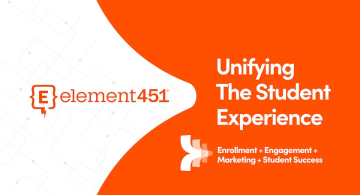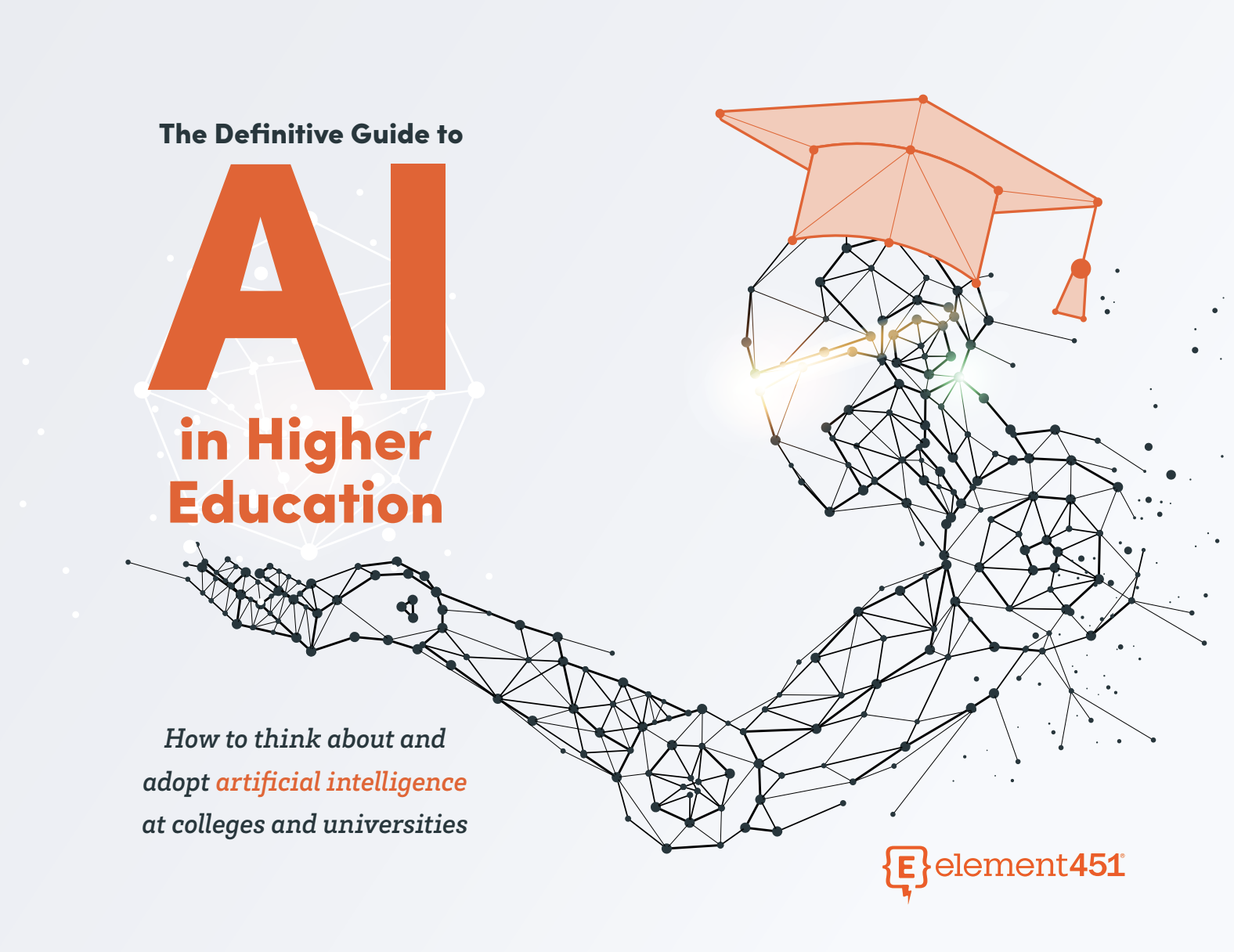How AI is Transforming Classroom Engagement: Insights from Sara Custer
by Josh Schwartz, Ed.D. · Updated Oct 04, 2024
In a recent Enrollify episode of Mastering the Next, Dr. Ray Lutzky, from Element451 spoke with Sara Custer, Editor-in-Chief at Inside Higher Ed, to discuss the profound ways artificial intelligence (AI) is reshaping classroom engagement.
Their conversation explores how AI is enhancing teaching efficiency, enabling personalized learning experiences, and prompting critical ethical discussions about privacy and data usage. Sara and Ray discuss the ongoing and future impacts of AI in education, offering insights on the tools and methods transforming how instructors connect with students.
Key Takeways
- AI has been enhancing classroom engagement for years, even before the advent of popular tools like ChatGPT.
- Faculty use AI to streamline tasks such as lesson planning, grading, and providing student feedback, freeing up time for more direct engagement.
- Cutting-edge AI tools, such as virtual teaching assistants and AI-powered learning platforms, offer personalized, interactive experiences for students.
- Privacy and ethical concerns surrounding data collection and student interaction with AI are becoming increasingly important.
- Institutions are nurturing faculty leaders and student ambassadors to help integrate AI into teaching, creating a collaborative approach to technology adoption.
AI's Long-Standing Role in Education
AI’s role in education is not a recent development, despite the media frenzy around the launch of ChatGPT. As Sara Custer explains, higher education institutions have been utilizing AI for years to streamline the more mundane, yet time-consuming tasks in teaching. Tools that help automate grading, generate lesson plans, or facilitate quick responses to student queries have been in place long before 2022. These technologies might not always be visible to students, but their impact is profound in the way they help educators manage time and workload.
Faculty now have the opportunity to shift their focus from administrative tasks to more meaningful interactions with students. AI frees up valuable time, allowing educators to adapt lesson plans, develop new instructional methods, and provide personalized support. This long-standing AI infrastructure is foundational to today’s classrooms, quietly enabling a more efficient, responsive, and student-centered learning environment.
Moreover, the arrival of AI tools like ChatGPTEDU is an extension of what has already been evolving. As more sophisticated AI systems become accessible to a broader range of institutions, the potential for more customized, dynamic student experiences grows. These tools help educators engage more deeply with students by automating repetitive tasks, giving them the space to be creative and innovative in the classroom.
Innovative Tools Transforming Classroom Engagement
One of the most exciting areas of AI innovation in education, as discussed by Sara, is the rise of AI-powered tools that actively engage students in new and dynamic ways. Institutions like Morehouse College are pioneering the use of 3D virtual teaching assistants, or “bots,” that are trained on specific course materials. These bots can answer students’ questions in real-time, ensuring responses are directly relevant to the course content. This level of interactivity goes beyond traditional teaching methods, providing students with on-demand support and allowing faculty to focus on higher-level tasks.
This technology not only enhances the student learning experience but also alleviates the burden on faculty, who no longer need to be available 24/7 to address routine inquiries. AI handles common student questions—whether about assignments, course logistics, or deadlines—allowing students to get immediate feedback and stay on track with their coursework. This personalized, self-paced learning model is becoming essential as more institutions move toward flexible, digital learning environments.
AI is also being integrated into less traditional fields of study, such as agriculture and debate. At the University of New Mexico, for example, faculty were incentivized to use AI to develop open educational resources (OER), while agriculture programs are employing AI-driven tools to monitor tasks like crop health and livestock feeding. In debate programs, AI assists by moderating student discussions and offering real-time suggestions for improvement, enabling students to hone their skills in a tech-enhanced environment.
At the heart of this transformation is Element451’s StudentHub, which takes AI-driven student engagement a step further. StudentHub serves as a centralized platform where students can manage every aspect of their academic life:
- Unified Resource Hub: Students can access their tasks, appointments, and course materials all in one place. For instance, a student might schedule advising sessions, view upcoming assignment deadlines, and join study groups through a single, streamlined platform. This unified experience minimizes confusion and keeps students focused on their academic goals.
- Automated Interventions: AI sends alerts and recommendations when a student might be struggling. If a student misses multiple assignments or has a significant drop in performance, the system can trigger an automated alert offering academic support or reminding them of upcoming deadlines. This proactive approach keeps students engaged and ensures timely intervention before issues become critical.
- Enhanced Communication Channels: Push notifications help students stay on top of important deadlines or events. For example, a student could receive reminders for financial aid application deadlines, course registration windows, or even campus events. By delivering real-time, personalized updates, students are better equipped to stay organized and make informed decisions about their academic journey.
By integrating tools like StudentHub, institutions can provide a more holistic and supportive learning environment. AI ensures that students remain connected and informed, while faculty benefit from streamlined communication and engagement workflows. These innovations mark a significant shift in how technology supports both teaching and learning in higher education.

See Bolt Discovery in Action
Replace traditional web search with real-time, personalized recommendations tailored to student interests.
Get A Demo
Ethical Considerations: Privacy, Data, and the Future of AI
While the possibilities of AI in education are thrilling, they come with significant ethical challenges, particularly around data privacy. As Sara points out, AI’s increasing role in the classroom raises important questions about how student data is collected, stored, and used. With AI tools analyzing everything from students’ engagement levels to their academic progress, institutions must tread carefully to ensure that data is used ethically and that students' privacy is safeguarded.
There is also the issue of bias in AI systems. If not properly managed, AI algorithms can perpetuate biases, particularly in automated grading systems or personalized learning paths. Ensuring that AI tools are transparent and fair is crucial to maintaining the integrity of education and protecting students from unintended consequences.
Educational institutions are already taking steps to address these ethical concerns. Many are developing policies around AI usage, clearly communicating with students and faculty about what data is being collected and how it will be used. Institutions must strike a balance between leveraging the full potential of AI to enhance learning while safeguarding the rights and privacy of all students. This ongoing discussion about the ethical implications of AI is as important as the technology itself.
Supporting Faculty in the AI Transition
Introducing new technologies like AI into education is not without its challenges, particularly when it comes to faculty adoption. As Sara mentions, there are always early adopters who embrace these tools eagerly, but there are also those who are more resistant to change. To bridge this gap, institutions are focusing on fostering AI “champions” within their faculty—those who can demonstrate the benefits of AI to their peers.
Institutions like Georgia Tech have launched pilot programs to encourage faculty members to test AI tools in small, manageable ways. These initiatives allow educators to experiment with AI in their classrooms without overhauling their entire teaching process. When they see firsthand how AI can streamline tasks and improve the student experience, they are more likely to embrace it fully.
Another innovative approach is the involvement of student ambassadors. In some cases, tech-savvy students are helping faculty understand and use AI tools effectively, creating a form of reverse mentoring. This collaborative effort between students and educators reflects a shared responsibility in adapting to technological change and ensures that AI is used in a way that enhances learning for all involved.
The Future of AI in Education
As AI continues to evolve, its role in higher education will only grow. The tools and technologies discussed in this episode represent just the beginning of what’s possible. AI has the potential to revolutionize how we think about learning, making education more personalized, interactive, and accessible. However, with this potential comes the responsibility to ensure that AI is used ethically and inclusively, addressing both the opportunities and challenges that lie ahead.
For educators, institutions, and students, the key is not to see AI as a replacement for human interaction but as a tool that enhances the learning experience. By embracing AI’s ability to automate, personalize, and innovate, the future of education can be one that is more engaging and tailored to each student's unique needs.

About Element451
Boost enrollment, improve engagement, and support students with an AI workforce built for higher ed. Element451 makes personalization scalable and success repeatable.
Categories
New Blog Posts

The Definitive Guide
AI in Higher Education
Bridge the gap between the latest tech advancements and your institution's success.
Useful Links

Talk With Us
Element451 is the only AI Workforce Platform for higher education. Our friendly experts are here to help you explore how Element451 can improve outcomes for your school.
Get a Demo






